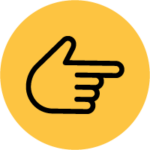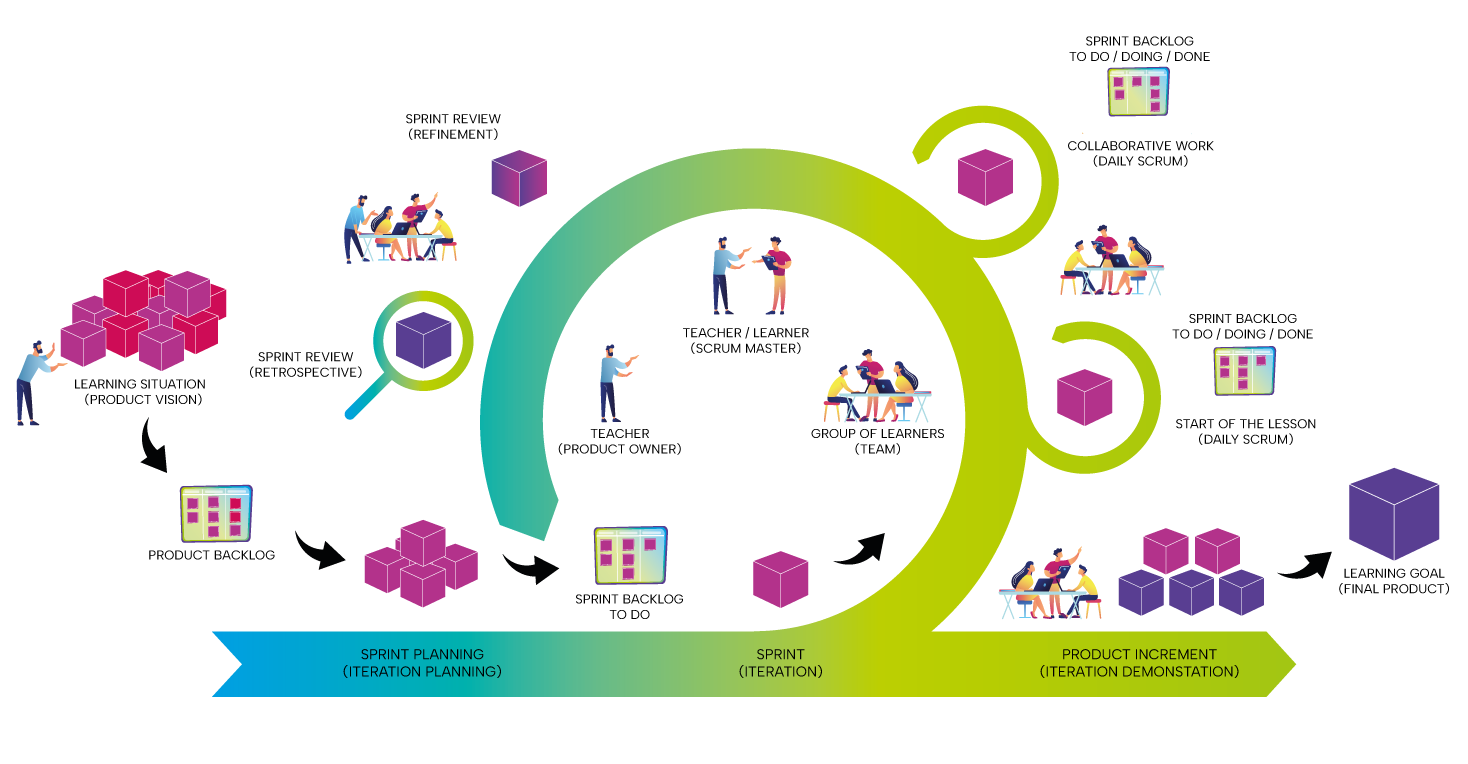Scrum process adapted for schools with a description of the artefacts and roles

Please zoom in your browser to see a larger graphic. You can use the „Shift and +“ of your keyboard or the Zoom-function of your browser (Menu in the top). To go back to the learning module, please close this window.

PRODUCT BACKLOG
The product backlog contains all work orders and the requirements that the product must fulfil (items). User stories are also described in the items. In school, the product backlog is the comprehensive work order that the teacher discusses with the group of learners during the product backlog refinement. The assignment usually includes the creation of a product.
TEACHER (PRODUCT OWNER)
The Product Owner is the client of the project. They determine the content of the product backlog, may change it and decide which items are currently most important (prioritisation). In school, the teacher is the Product Owner. He also hands over the order.
GROUP OF LEARNERS (TEAM)
The development team is a group of developers from different disciplines (interdisciplinary team). The development team receives an assignment from the Product Owner, which is described by items in the product backlog. The team makes a promise to achieve the goal for each sprint. It is important that the tasks are estimated in advance relative to each other (planning poker/estimating). In school, the development team is a group of learners who work together on the assignment.
THE SCRUM MASTER
The Scrum Master is responsible for the Scrum process. For example, they ensure that the daily stand-up is held. The Scrum Master supports the team in solving problems. In school, this is the teacher who is currently teaching the class or a learner from the team.
SPRINT BACKLOG
The sprint backlog contains all the tasks that the development team has to complete in the next sprint. The respective sprint goal is discussed in advance with the Product Owner during sprint planning. In school, these are tasks.
PRODUCT INCREMENT
The product increment is a deliverable (partial) product that has been tested in accordance with the definition of done. In school, this is a finished (partial) result that the group of learners presents to the teacher in the review.
SPRINT RETROSPECTIVE
The sprint is reflected in the retrospective. The aim of the sprint is to improve teamwork from sprint to sprint. In school, the retrospective takes place at the end of each sprint, usually directly after the sprint review.
SPRINT REVIEW
During the sprint review, the development team presents its work. Only finished (partial) products (increments) are delivered. These increments are approved by the Product Owner. New items resulting from the review are included in the product backlog. In school, the group of learners shows the teacher the finished (partial) results at the end of the sprint.
SPRINT (ITERATION)
A sprint is a unit of time in which the tasks of the sprint backlog are processed. In school, for example, a sprint lasts 8 lessons. The sprint is planned in advance by the group of learners during sprint planning.
DAILY SCRUM / START OF THE LESSION
Every working day begins with the daily scrum (stand-up). Each employee answers three questions:
- What did I achieve in the last meeting?
- What am I doing today?
- What obstacles are there?
In school, every lesson begins with stand-up. It lasts a maximum of five minutes (time-boxing). The teacher can also answer questions about the assignment during the stand-up.
SPRINT PLANNING
The sprint is planned in advance by the development team during sprint planning. In school the group of learners planned the tasks.
DAILY SCRUM / COLLABORATIVE WORK
Collaborative work
PRODUCT BACKLOG with PB-ITEMS and USER STORIES
TO DO tasks to be completed
DOING Task in progress
DONE Task completed
A board with the columns "To do", "Doing" and "Done" can be used for the tasks. If a group of learners work on one task, the task moves from the column "To Do" into the column "Doing". If the task is completed, the task moves to "Done".
LEARNING SITUATION / PRODUCT VISION
The product vision is the desired goal of the project with all its contents and items collected in the product backlog. In school, the learning situation is the product vision.
The teacher determines the content of the product backlog, may change it and decides which items are currently most important (priorisation).
LEARNING GOAL / FINAL PRODUCT
The final product is completed in the last sprint. Everything is integrated and tested. In school, the learning goal is achieved.
![]()
Scrum for schools I Mechthild Wiesmann and Andrea Schönwandt I Center for teacher education of the University of Cologne (https://zfl.uni-koeln.de/das-zfl) I CC BY-SA 4.0 (https://creativecommons.org/licenses/by-sa/4.0/)
